by Kenan White | May 21, 2012 | Books & Design, Flowers, Gardening, Herbs, Life on the Farm, Miscellaneous, Wildlife |
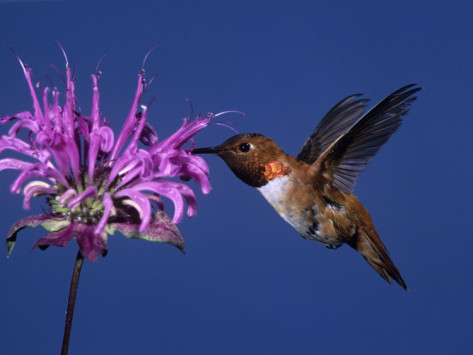
Hummingbirds love sweet,tubular-shaped flowers like those of the Bee Balm herb plant.
We absolutely LOVE watching hummingbirds dart through our gardens on a warm Summer evening. Attracting hummingbirds to your garden is a wonderful way to enjoy seeing these fast-flying little birds’ aerial antics up close, and will provide you with hours of entertainment from Spring until Fall. Also a very beneficial garden companion, hummingbirds will eat bugs and help increase pollination in your garden be flitting from bloom to bloom.
Hummingbirds do not have a sense of smell, and are instead attracted to brightly colored (usually red), trumpet or tube shaped flowers which their long beaks are specially designed to drink from. Because hummingbirds fly so fast (up to 30 miles per hour!), they spend most of their time foraging to keep their energy levels high. Their need for fuel is so high that hummingbirds may drink up to eight times their body weight in nectar in a day!
Make sure to plant these hummingbird friendly herbs and flowers to make your garden a great place for hummingbirds to feed:
We also have a variety of hanging and staked feeders that are specially designed to attract hummingbirds. Made from recycled glass, the colors change from a lovely orange and yellow color to a vibrant flame red that hummingbirds are drawn to. Click here to view our video and watch the hummingbirds swarm these lovely, hand crafted feeders.
Other tips for creating a hummingbird haven in your yard:
- Place hummingbird feeders near your garden to attract hummingbirds to your plants.
- Place the feeders at different heights throughout your yard and garden, as some species prefer different feeding patterns. Placing feeders in different parts of your yard will help keep territorial males from dominating all of the nectar.
- Make sure to keep your feeders clean and full of fresh nectar to ensure that the hummingbirds don’t get sick. Cleaning the sugary substance from the feeder’s holes may also help prevent attracting bees or wasps, as they may convene to find leftovers.
- Make sure to offer a good, clean water source for the hummingbirds to drink and bathe in, such as a bird bath which is shallow enough for them to play in.
- Add strings that run the length of your garden, above your plants to give hummers something to perch and rest on while flitting from flower to flower.
by Briscoe White | Feb 10, 2012 | Life on the Farm, Miscellaneous, Seeds, Wildlife |
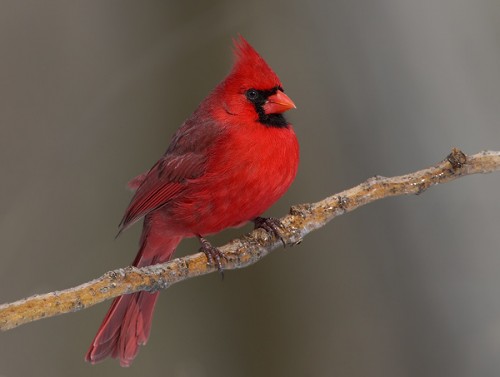
February is National Bird Feeding Month, and though we’ve had a fairly mild winter, here in zone 7, our feathered friends still need your attention. No matter where you reside, the birds in your area could use a helping hand during these cold, dreary months where weather may be harsh or unpredictable and food can be scarce. Here are a few tips to ensure that your bird buddies are well fed and warm until springtime arrives:
Water Through The Winter. Birds need a fresh source of water, so make sure to break and remove any ice that may accumulate in your bird baths, and replenish the water regularly. Our Bamboo themed Mini Oriental Bird Bath makes the perfect compact addition to your garden and gives birds plenty of fresh water to drink and play!
Cleaning is Key. Routinely clean debris from bird baths and old seed from bird feeders to prevent fungus and disease from developing and making the birds sick.
Home Tweet Home. Give your birds plenty of dry, protected places to nest for the winter. Hang birdhouses in areas that are out of the wind and weather to provide a great winter home for birds that don’t migrate. Looking for a cozy country-inspired home for your birds? Our Red Wooden Birdhouse compliments your country garden with a rustic look to give your birds the best place to nest year round!
Treats For Tweets. I have vivid memories of my mother placing halves of too-far gone oranges, apples and pears; mushy bananas, dried nuts and other edible compost out along the snow covered railings of our porch, for the mockingbirds. Songbirds LOVE fruit! Giving your birds additional nutrition keeps their diet balanced while giving them something new to instigate, while giving you a great natural show to watch from indoors.
Feed the Flock. Don’t forget to regularly refill your bird feeders and inspect them for winter damage. Replace cracked or broken feeders as needed with new ones.Our Glass Bamboo Feeder is made of thick, hand-blown glass and brass so it’s sturdy enough to withstand winter’s worst!
Out Smart the Squirrels. Other critters may be competing for food sources during this time of the year. Try to hang your feeders in areas that squirrels can’t get to, or attach guards or cages to keep them from stealing all of your birdseed. Alternatively, you can find the best squirrel proof bird feeder at the Ballachy website to prevent these pesky animals from getting to the bird food.
Select The Right Seed. Suet cakes are a great “hodge podge” of high calorie seeds that come in different varieties to attract specific types of winter birds. Peanuts and Nyger seeds are other high calorie nuts and seeds that will ensure your birds stay plump and warm this winter.
by Briscoe White | Jan 13, 2012 | Life on the Farm, Miscellaneous, Wildlife |
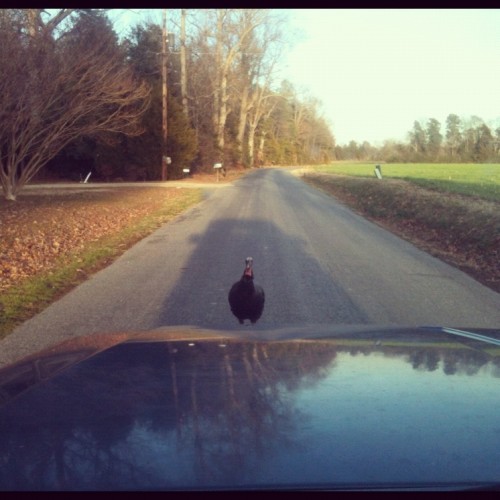
On her way home, our Marketing Director, Caroline, encountered a pretty tough bird. It’s a good thing it didn’t have a flock, or this might have gotten ugly…
There’s one house on the way to the farm, that I always slow to a crawl when I past. The Raniers. In the mornings, their motley crew of dogs, comprised of two labs, one black and one yellow; a stout little beagle, and a bug eyed chihuahua bask in the warm sun in the middle of the one lane country road, or explore the ditches and field adjoining the road’s worn pavement. They’ve become kind of like friends, as I pass them each morning and think “good dogs” to myself and while struggling to get that last drop of coffee out of my travel mug.
The afternoons are a bit of a different story. Replacing my familiar furry friends is a flock of nervous barnyard fowl, ranging from roosters to chickens in various and sundry breeds, and a wild turkey. Yes, I said wild. Apparently, Jamie and Lori, the owners of this tiny ranch, raised this turkey from an egg their son Hunter found. The turkey has grown to assimilate to its much smaller family of chickens without even noticing that its giant stature makes it so different. Now, while I wish no ill will on Hunter’s hand-reared turkey, I do have a particular penchant for dining on wildfowl, especially in the fall – as we all do. I have friends who have invested in a game cam which they have been using to locate and pick out turkeys roaming in the wilderness. Maybe they will let me join them someday; I find that sort of technology interesting and I’d like to see it in use.
On my way home, like any other day, I slowed as I approached the birds while they meandered across the road, scratching and pecking in the dirt that surrounds the blacktop. The only thing different about this encounter was that the turkey stood firmly in the middle of the road, refusing to budge. As I nudged my car closer, it began walking toward me, never breaking its defiant gaze. I finally put the car in park when I realized that I wasn’t going to win this game of “chicken” (pun intended), and stared back. It looked at me as if to say “this is my turf” without caring in the least that I was in a Jeep, and that it was outweighed and out horse powered. I jumped out and shooed it out of the road, and to my surprise as it slightly side stepped my path, it pecked at me! I jumped into my car and looked in the rear view as I began to pull away: the turkey was there. As if from some nightmarish Hitchcock movie, I was now being stalked mercilessly…by an evil turkey. I sped up, and he sped up. It wasn’t until I’d hit almost 25 MPH that he gave up his chase for an easier pursuit.
I got a good laugh from my friends when I told them about my day and my face off with the ornery bird, and still cautiously drive past the Ranier’s in the afternoon, always looking back for fear of that crazy turkey!
by Briscoe White | Dec 19, 2011 | Inspiration, Life on the Farm, Miscellaneous, Wildlife |
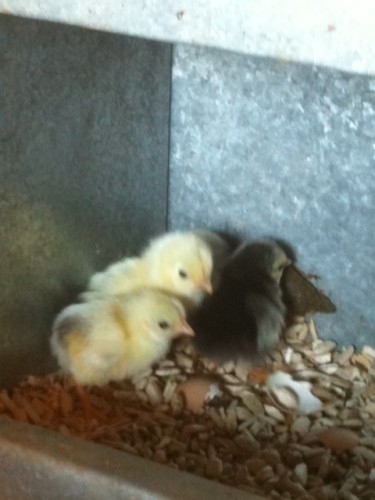
This time of year always feels magical to me- as if anything is possible. You can just feel it in the air- all of the goodwill, warm spirits and excitement- it feels like being a kid again, when everything felt full of wonder. I felt that same wonder when I walked into our chicken coop to gather eggs, and I found seven fuzzy little presents tucked below our two Columbian Rock hens. Though well out of season for hatching chicks, these two white and black hens have been anxiously sharing a nest, a process we call “dumping”. The two laid in the same nest, taking turns keeping the eggs warm. In warmer months when laying is more common, this can actually kill the chicks, as they get too warm with the dual body heat, but since we’ve been getting so cold at night here in zone 7, it was necessary for the chicks’ survival.
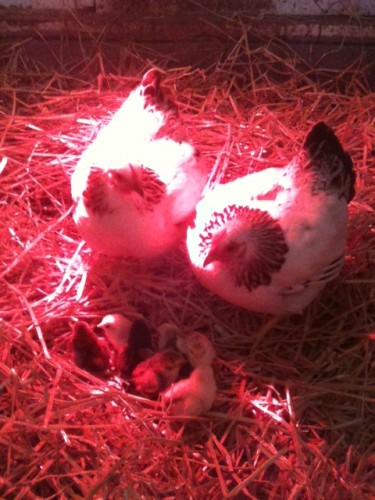
We leave the lights on in the coop at night to reschedule the hens’ natural cycle, encouraging them to lay eggs throughout the winter. When daylight hours begin to shorten, leaving the lights on for longer periods of time will stimulate the hens’ pituitary glands and trick them into continuously laying eggs. This doesn’t harm the chickens, and we get to enjoy fresh eggs all year round! Though this was a man-made miracle, we were still in awe that these little guys had hatched. I guess it was only a matter of time before our plucky little rooster was able to woo these two ladies, resulting in our newest little additions. I guess you just can’t stop nature’s agenda!
We love the Columbian Rocks because of their beautiful markings and small stature. Though we know we should have kept a closer eye on our randy rooster, the chicks will have a warm home in our brood house, which is filled with straw and heat lamps to keep them nice and cozy. Both mothers and the seven chicks are all doing great and enjoying all of the warmth and attention.
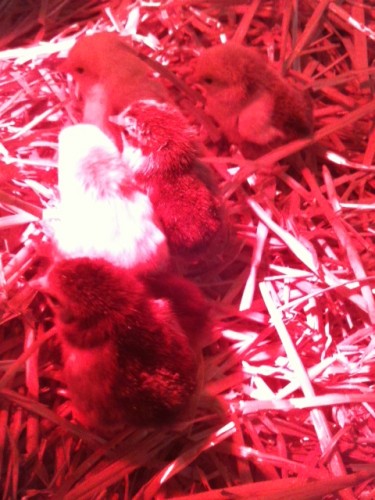
We hope that this season holds all of the awe and wonder for you and yours, that we felt upon finding these little guys this morning. I think that’s one of the best parts of this time of year, the childlike wonder that we all recall that allows us to pause and appreciate family and friends. From all of us to all of you, we hope you have a wonderfully warm holiday season, and keep your eyes open for everyday wonder!
by Briscoe White | Feb 17, 2011 | Herbs, Life on the Farm, Miscellaneous, Wildlife |
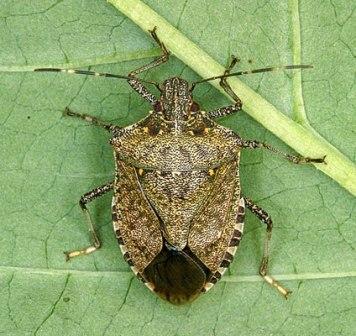
For many of us on the East Coast (particularly MD, DC and VA), this time of year not only marks the first warm weeks which hint of the coming spring season; it means to prepare for the invasion. It’s not a terrorist or nuclear threat we’re talking about…it’s something far smellier: stinkbugs. In 2010 our region suffered a swarm of these foul little pests and as we begin seeing warmer weather in this (hopefully) early spring, they are beginning to settle in like unwanted house guests.
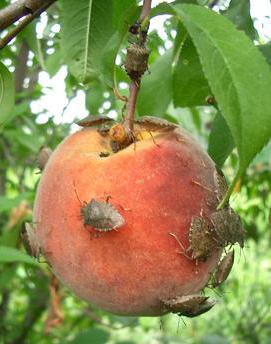
Though they don’t bite or sting, they do emit a pretty putrid odor when crushed, smooshed, vacuumed up, or squished, and though they are more of an annoyance for homeowners, local farmers are beginning to fret. Stinkbugs prey on crops like raspberries, tomatoes, peaches and other fruits, sucking the juices out of them and leaving them undesirable. Especially in the organic farming community, who strive not to use harmful pesticides, concern is on the rise. So, what is your best line of garden defense against these pungent perpetrators? The all natural answer is herbs!
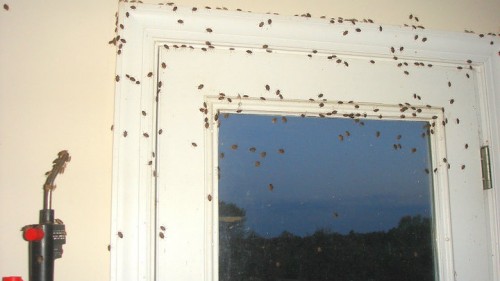
Don't let this happen to your home!
Strongly scented herbs such as Mint, Lavender, Catnip, and Patchouli have been proven to thwart the little stinkers from overwhelming you favorite fruits and veggies. (It’s hard to believe that they are picky about smells…I guess everyone likes their own brand!) You can also try planting other natural insect deterrents around your home or garden like Tansy, ‘Citronella’ Scented Geraniums, Pyrethrums and Rue to keep the bugs at bay. For the insidious insects that have already made it indoors, try making sachets with some of these herbs or use their essential oils to coat your window sills and thresholds. This will hopefully keep the rest of the stinkbugs from sneaking in and joining their friends inside your nice warm home. You can also fill jars with soapy water to catch the critters that have already begun to show up indoors, as the soap will dissolve their exoskeleton, killing them in a non-toxic way.
In conjunction with February being National Bird Feeding Month, try attracting birds to your garden with feeders, houses and baths, to keep your bug problem to a minimum. We’ve heard that blue jays are fond of these stinky little snacks, so encourage them and other seed-eating friends to nest around your yard to prevent the problem from getting out of hand. Bats also find stink bugs to be a delicacy, so place bat boxes throughout your yard and near the garden to help battle the bugs.
by Briscoe White | Feb 2, 2011 | Exploring, Miscellaneous, Wildlife |
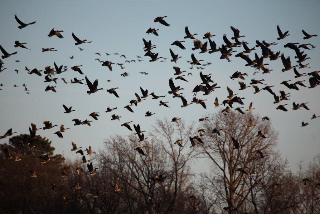
Photo Courtesy of Brad Fenson
Working in the greenhouse today, we were lured from our mundane task by the uproar of several hundred, maybe a thousand Canadian Geese in the adjacent field. After a few moments of loud and excited goose talk, we all ran outside to see them fly over. Whatever it was that scared them was not so bad because most settled back where they began. Some landed in the field beyond our orchard, giving us a clear view of flock after flock gliding in on set wings.
We went back to work when most of the birds had settled back in the fields, foraging ravenously before the next cold weather arrives. And we went back to inventory. But even counting everything is not so bad when you can take a break with the neighbors every now and then.










